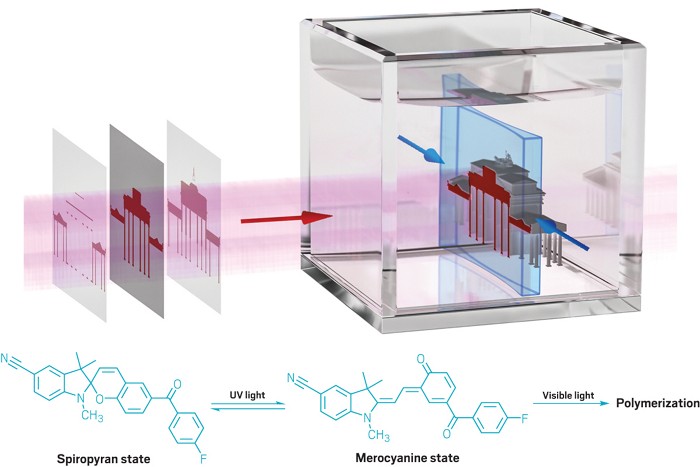3-D printing complex objects in a flash
02/02/2021 Taking advantage of molecules that s witch states when exposed to particular wavelengths of light, researchers have developed a 3-D printing method that can make precise objects in a matter of minutes. The technique, developed by Stefan Hecht of RWTH Aachen University, Martin Regehly of Brandenburg University of Applied Sciences, and colleagues at the Berlin-based start-up xolo, is called xolography because it uses the crossing of light beams to create whole objects (holo is the prefix for whole and x signifies criss-crossing). The technique offers a way to make multicomponent objects with fine details, such as flow cells with blades that spin on an axle for transporting and mixing reagents. Xolo plans to commercialize the xolographic printer.
witch states when exposed to particular wavelengths of light, researchers have developed a 3-D printing method that can make precise objects in a matter of minutes. The technique, developed by Stefan Hecht of RWTH Aachen University, Martin Regehly of Brandenburg University of Applied Sciences, and colleagues at the Berlin-based start-up xolo, is called xolography because it uses the crossing of light beams to create whole objects (holo is the prefix for whole and x signifies criss-crossing). The technique offers a way to make multicomponent objects with fine details, such as flow cells with blades that spin on an axle for transporting and mixing reagents. Xolo plans to commercialize the xolographic printer.Xolography is a variant of volumetric 3-D printing. Instead of laying material down layer-by-layer with nozzles, like most 3-D printing, volumetric methods use light to selectively polymerize portions of a container of viscous liquid and wash away the rest, resulting in a solid object. Interest is growing in volumetric 3-D printing to make objects with fine features. In contrast to other volumetric approaches, Hecht and Regehly’s xolography technique is both fast and doesn’t require the expensive equipment that some other volumetric techniques do.

In xolography, UV light (blue arrow) transforms a photoswitchable molecule from a spiropyran state to a merocyanine state. Visible light (red arrows) projected perpendicularly to the UV beam changes the merocyanine state of the molecule to a state that initiates polymerization where the beams intersect.
The new method relies on a photoswitchable molecule, which changes its structure when exposed to light. The researchers mix a photoswitchable spiropyran into the monomer-containing viscous liquid in their setup. When the researchers shine UV light on the material, the spiropyran molecules in the beam’s path switch to a merocyanine state. If the researchers then expose the molecules in the merocyanine state to visible light, the compounds initiate a polymerization reaction, hardening the viscous liquid. If merocyanine molecules don’t encounter visible light, they quickly switch back to the spiropyran state and no polymerization occurs. By shining the visible light from the perpendicular direction to the UV beam, the researchers can harden the liquid just at the point of intersection, giving precise control (Nature 2020, DOI: 10.1038/s41586-020-3029-7).
Hecht, who has studied photoswitchable molecules for 15 years, says his group tried many molecules before finding the right one for xolography. He notes that for data storage, most switchable molecules have to be slow at moving back to their original state. But for this application, they wanted the molecules to switch back quickly so they wouldn’t initiate polymerization in unwanted areas. This fast switching also speeds up the printing process.
The researchers report making structures with micrometer precision, but Vittorio Saggiomo, who studies 3-D printing at Wageningen University and Research, says the group should be able to achieve even finer features in the objects they create by using certain fluorescent microscopy set-ups. The challenge, he says, will be creating objects that are larger than 10 cm because of light diffraction, scattering, and absorption.
“Xolography represents an elegant leap forward in 3-D printing technology by embracing the inherent interdisciplinarity of this arena, which brings together, among other things, innovative synthetic materials and optical engineering,” says University of Texas at Austin’s Zachariah Page, a 3-D printing expert, in an email. “It is a truly exciting advance in manufacturing that enables an unmatched combination of speed and resolution, while further demonstrating the power of light.”
Source: https://bitlybr.com/0wtWnP, via Chemical & Engineering News

